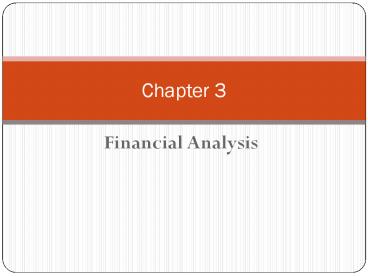Financial Analysis - PowerPoint PPT Presentation
Title:
Financial Analysis
Description:
Financial Analysis Chapter 3 - Outline Financial Analysis 4 Categories of Financial Ratios Importance of Ratios Inflation and its Impact on Profits Financial Analysis ... – PowerPoint PPT presentation
Number of Views:874
Avg rating:3.0/5.0
Title: Financial Analysis
1
Chapter 3
- Financial Analysis
2
Chapter 3 - Outline
- Financial Analysis
- 4 Categories of Financial Ratios
- Importance of Ratios
- Inflation and its Impact on Profits
3
Financial Analysis and Ratios
- What is financial analysis?
- Evaluating a firms financial performance
- Analyzing ratios or numerical calculations
- Comparing a company to its industry
4
4 Categories of Ratios
- Profitability Ratios
- Asset Utilization Ratios
- Liquidity Ratios
- Debt Utilization Ratios
5
Classification System
- We will separate 13 significant ratios into four
primary categories. - A. Profitability Ratios.
- 1. Profit margin.
- 2. Return on assets (investment).
- 3. Return on equity.
- B. Asset utilization ratios.
- 4. Receivable turnover.
- 5. Average collection period.
- 6. Inventory turnover.
- 7. Fixed asset turnover.
- 8. Total asset turnover.
- C. Liquidity ratios.
- 9. Current ratio.
- 10. Quick ratio.
- D. Debt utilization ratios.
- 11. Debt to total assets.
- 12. Times interest earned.
- 13. Fixed charge coverage.
6
TABLE 3-1 Financial statementfor ratio analysis
7
Profitability Ratios
- Show how profitable a company is.
- The ratios express
- Profit Margin or Return on Sales ()
- Return on Assets or Return on Investment ()
- Return on Equity ()
8
Profitability Ratios
- Saxton Company Industry Average
- 1. Profit margin 5 6.7
- 2. Return on assets (investment)
- a. 12.5 10
- b. 5 ? 2.5 12.5 6.7 ? 1.5 10
- 3. Return on equity
- a. 20 15
- b. 20 15
?
9
FIGURE 3-1 Du Pont analysis
10
Return of Wal-Mart versus Macys using the Du
Pont method of analysis, 2007
11
Asset Utilization Ratios
- Show how effectively a company uses its assets.
- The ratios express
- Receivables Turnover (times)
- Average Collection Period (days)
- Inventory Turnover (times)
- Fixed Asset Turnover (times)
- Total Asset Turnover (times)
12
Asset Utilization Ratios
Saxton Company Industry
Average 4. Receivables turnover
11.4 10 times 5. Average
collection period 32 36 days 6.
Inventory turnover 10.8 7 times
Accounts receivable Average daily credit sales
13
Asset Utilization Ratios
Saxton Company Industry Average 7. Fixed
asset turnover 5 5.4
times 8. Total asset turnover 2.5
1.5 times
14
Profitability and Turnover Ratios
- Remember
- Return on X Net Income / X
- X Turnover Sales / X
15
Liquidity Ratios
- Show how liquid a company is or how much it has
to meet S/T needs. - The ratios express
- Current Ratio (times)
- Quick Ratio or Acid-Test Ratio (times)
16
Liquidity Ratios
-
Saxton Company Industry Average - 9. Current ratio
- 2.67 2.1
- 10. Quick ratio
- 1.43 1.0
Current assets Current liabilities
800,000 300,000
Current assets - Inventory Current liabilities
430,000 300,000
17
Debt Utilization Ratios
- Show how well a company is managing or using
debt. - The ratios express
- Debt-to-Total Assets ()
- Times Interest Earned (times)
- Fixed Charge Coverage (times) (Fixed Charges
lease payments, i expense)
18
Debt Utilization Ratios
Saxton Company Industry Average 11. Debt
to total asets
37.5 33 12. Times interest earned
11 7 times 13. Fixed charge coverage
6 5.5 times
600,000 1,600,000
550,000 50,000
600,000 100,000
19
TABLE 3-3 Ratio analysis
20
FIGURE 3-2 Trend analysis
21
Trend Analysis in the Computer Industry
22
TABLE 3-7 Comparison of replacementcost
accounting and historicalcost accounting
23
Inflations Impact on Profits
- FIFO (First-In, First-Out) Inventory
- Lowers COGS
- Raises Profits
- LIFO (Last-In, First-Out) Inventory
- Raises COGS
- Lowers Profits
24
Importance of Ratios
- Which ratio is most important?
- It depends on your perspective.
- Suppliers and banks (lenders) are most interested
in liquidity ratios. - Stockholders are most interested in profitability
ratios. - A long-run trend analysis over a 5-10 year period
is usually performed by an analyst.






























